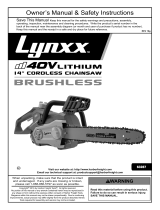Portland Item 64497-UPC 193175354846 Owner's manual
- Category
- Power tools
- Type
- Owner's manual
This manual is also suitable for
Portland Item 64497-UPC 193175354846 is a chain saw. It is an electric, hand-held power tool that is used for cutting wood. The chain saw has a number of safety features, including a chain brake, a hand guard, and a safety trigger. The chain saw also comes with a number of accessories, including a guide bar, a chain, and a carrying case.
The chain saw is capable of cutting through a variety of wood types, including softwoods, hardwoods, and laminated wood. It can also be used to cut through branches, roots, and other obstacles.
Portland Item 64497-UPC 193175354846 is a chain saw. It is an electric, hand-held power tool that is used for cutting wood. The chain saw has a number of safety features, including a chain brake, a hand guard, and a safety trigger. The chain saw also comes with a number of accessories, including a guide bar, a chain, and a carrying case.
The chain saw is capable of cutting through a variety of wood types, including softwoods, hardwoods, and laminated wood. It can also be used to cut through branches, roots, and other obstacles.




















-
 1
1
-
 2
2
-
 3
3
-
 4
4
-
 5
5
-
 6
6
-
 7
7
-
 8
8
-
 9
9
-
 10
10
-
 11
11
-
 12
12
-
 13
13
-
 14
14
-
 15
15
-
 16
16
-
 17
17
-
 18
18
-
 19
19
-
 20
20
Portland Item 64497-UPC 193175354846 Owner's manual
- Category
- Power tools
- Type
- Owner's manual
- This manual is also suitable for
Portland Item 64497-UPC 193175354846 is a chain saw. It is an electric, hand-held power tool that is used for cutting wood. The chain saw has a number of safety features, including a chain brake, a hand guard, and a safety trigger. The chain saw also comes with a number of accessories, including a guide bar, a chain, and a carrying case.
The chain saw is capable of cutting through a variety of wood types, including softwoods, hardwoods, and laminated wood. It can also be used to cut through branches, roots, and other obstacles.
Ask a question and I''ll find the answer in the document
Finding information in a document is now easier with AI
Related papers
-
Portland Item 64497 Owner's manual
-
Portland Electric 15 Inch Chain Saw Owner's manual
-
Portland Item 64497-UPC 193175415547 Owner's manual
-
Portland 56808 Owner's manual
-
Portland 56808 Owner's manual
-
Chicago Electric Owner's Manual & Safety Instructions Owner's manual
-
Portland 58949 Owner's manual
-
Portland Item 63190 Owner's manual
-
Portland 62896 Owner's manual
-
Portland 56808 9.5 In. 7 Amp Corded Electric Pole Saw Owner's manual
Other documents
-
Ryobi RY40530 Owner's manual
-
Ryobi RY405100 User manual
-
Ryobi ZRRY40530 User manual
-
Ryobi P547 Owner's manual
-
Craftsman 172341201 Owner's manual
-
Craftsman 172740500 Owner's manual
-
Worx WG305E 25cm Chainsaw User manual
-
 Astella CT200 Operating instructions
Astella CT200 Operating instructions
-
 Winsome House WHAP341 Operating instructions
Winsome House WHAP341 Operating instructions
-
 Lynxx 63287 Owner's manual
Lynxx 63287 Owner's manual






















